The application of analysis to the study of theory is obvious, as long as theory is concerned with musical relationships, with how these relationships are articulated in a piece and how the analytic reasoning is supported. The pertinence of analysis to composition is also clear, as long as composition concerns the creating of related events in a musical work.
Analysis can also be used to teach "appreciation," since appreciation can result only from what is perceived (i.e., it is difficult to appreciate what is not noticed) and since analysis directs hearing, thereby increasing the involvement of the auditor—layman or musician—in the perception of the music's own processes.
Application of analysis to the intricate problem of arriving at critical judgments may be a subject for later considerations, involving the question of whether a lack of analytic comment about a work reflects the lack of substance that is worth commenting on in that work.
And deriving an interpretation from an analysis may also be problematic, since many aspects of performance practice are inadequately questioned, accepted as matters of tradition, style or "taste," and since, as is well known from the study of politics and other areas of human interaction, any "fact" can either be ignored entirely or merely re-interpreted, finally to become powerless when confronted by a strong and previously determined opinion. And a "fact" can be explained in any number of ways, depending on the position from which it is observed. Since analytically determined relationships may not be classifiable as "facts" in any case, the application of analysis to performance may meet obstacles.
Nevertheless, analysis can, within limits, at least support an interpretation. For example, in one discussion of the second movement of Mozart's Clarinet Quintet, K.V. 581, the following segmentation of the opening measures is suggested:
Ex. 1. Mozart, Clarinet Quintet, K.V. 581, mvt. ii.
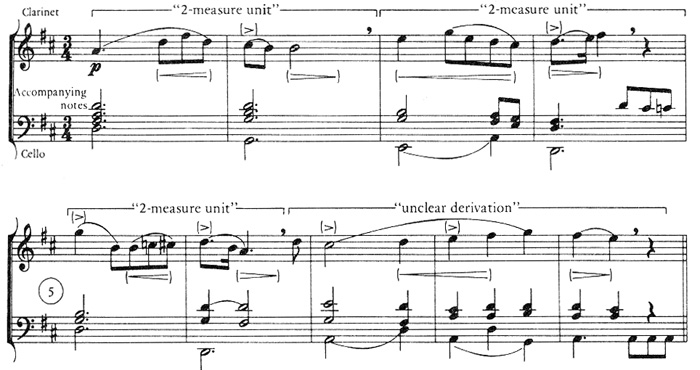
- mm. 1-4 is one phrase, sub-divided into two two-measure units;
- mm. 5-9 is the second phrase, sub-divided into a two-measure unit and a three-measure unit, with uncertainty about how to explain m. 7.1
This reading would produce, quite clearly, a symmetrical performance, as indicated in Ex. 1, with:
- a strong downbeat stress on the first note of m. 2 for the accented dissonance;
- a similar downbeat stress on the first note of m. 4 for the arrival at the tonic;
- straightforward metric stresses on the first notes of mm. 5 and 6; and
- no clear indication of how to play mm. 7-9 because, admittedly, there seems to be no motivation for the extension here into a three-measure unit.
However, it is noticeable that the second group of six notes in the clarinet line is sequential to the first six notes, one step higher and with a shift of metric placement and rhythmic values, Ex. 2.2
Ex. 2.

Now, since it is clearly untenable to suppose that Mozart could not hear what he wrote, it is also clearly unacceptable to conclude that this relation of the second six to the first six notes is just coincidence. And an unwillingness to accept this conclusion of mere fortuity leads to a different analysis, starting from the perception of pitch contour as defined by these two groups of six notes.
In fact, even before further analysis, if the clarinet's half-note in m. 2 (concert B) is heard as part of the six-note sequential repetition and therefore as connected to the notes of m. 3, as shown in Ex. 2, then this note B becomes an upbeat to m. 3, and instead of having that note "rounded off" (e.g., played with a slight diminuendo) as the last note of a unit would ordinarily be, it is given the slightest crescendo to lead into m. 3. This interpretation would negate the overly obvious and overly balanced (and unstylistic) symmetry in favor of an elegant and subtle asymmetry and a sense of motion.
With a detailed analysis of the registral levels of these few measures, the sense of asymmetry becomes even more evident.3 As Ex. 3 shows:
| 1. | the first note, A, starts the melodic line's lower registral level. It belongs to the basic layer because it is: |
| a. | consonant over a I ; ; |
|
| b. | stressed metrically; and | |
| c. | stressed agogically; |
| 2. | the D, also consonant over the same I , is short and metrically unstressed in both appearances. Therefore, while perhaps not yet itself a basic structural note, the D prepares the middle registral level; and , is short and metrically unstressed in both appearances. Therefore, while perhaps not yet itself a basic structural note, the D prepares the middle registral level; and |
| 3. | the  is also short and unstressed, except that it is the highest note in the line and therefore, at the very least, prepares the line's upper level. is also short and unstressed, except that it is the highest note in the line and therefore, at the very least, prepares the line's upper level. |
Ex. 3.
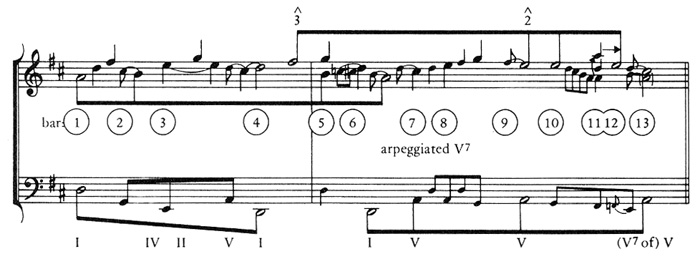
The contour in m. 1, then, outlines the tonic triad and each of this triad's three notes begins one of the three registral levels of the melody's basic structural line. In m. 2, the dissonant  resolves immediately to B. This B—particularly the second, the half-note B—is stressed, supported by a IV
resolves immediately to B. This B—particularly the second, the half-note B—is stressed, supported by a IV and occupying the entire measure. Therefore, this B continues the lower level, following from the A in m. 1.
and occupying the entire measure. Therefore, this B continues the lower level, following from the A in m. 1.
With the second B in m. 2, the six-note sequence begins; but since the chord does not change to emphasize it, this second B is an elision, the end of the first unit (a continuation of the eighth-note B) and also the start of the next. The motion of the B into m. 3 is to a metrically and rhythmically stressed E, supported by a  triad of which E is also the root, and then to G, the high note of the line. Because of the metric displacement and rhythmic changes, the E of m. 2 is in a more stressed position than its corresponding note, which precedes it on this level, the D of m. 1. The middle level's prominence is therefore similar now to the lower level's, indicating that a strong D (the tonic) will occur to resolve this E.
triad of which E is also the root, and then to G, the high note of the line. Because of the metric displacement and rhythmic changes, the E of m. 2 is in a more stressed position than its corresponding note, which precedes it on this level, the D of m. 1. The middle level's prominence is therefore similar now to the lower level's, indicating that a strong D (the tonic) will occur to resolve this E.
And m. 2's G continues from m. 1's  on the upper level, as its structural "neighbor" that awaits resolution back to the
on the upper level, as its structural "neighbor" that awaits resolution back to the  just as the E does to the D, Ex. 4.
just as the E does to the D, Ex. 4.
Ex. 4.

The harmonic rhythm becomes a bit faster in m. 3, with a change to a V chord for the third beat; and the combination of metric placement and chord function makes this chord an upbeat, requiring resolution to the I of m. 4. Consequently, the D of m. 4 is the stressed note for the middle level; and the last note of the measure, the  , is a return from the G of m. 3 to this structural note of the upper level, Ex. 3 and Ex. 4.
, is a return from the G of m. 3 to this structural note of the upper level, Ex. 3 and Ex. 4.
Now, the motion of the elided B in m. 2 across the bar line has created asymmetry, for the first pitch-group is now less than two measures long and the second one (with the added notes of m. 4) is now more than two measures long, Ex. 5.
Ex. 5.
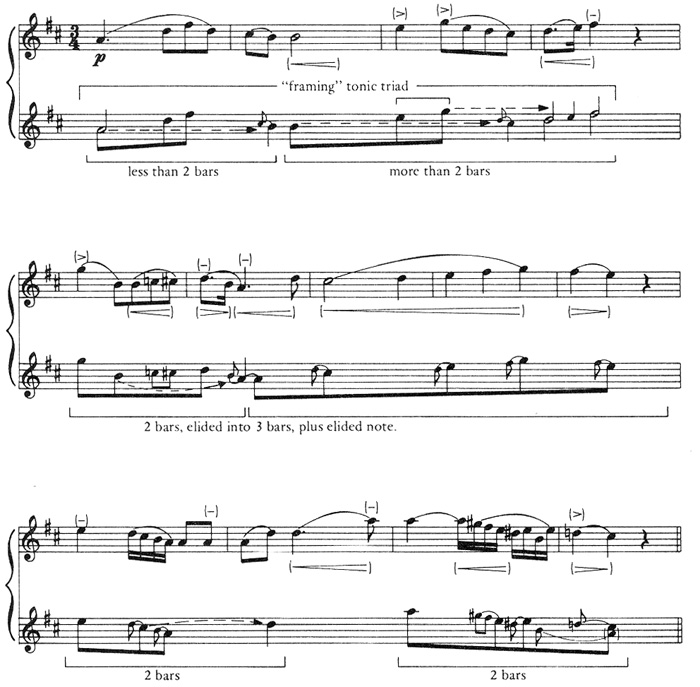
In performance, then, as indicated in Ex. 5, the B of m. 2 has a crucial role:
when played with a little crescendo, the B of m. 2 leads to the E of m. 3;4 this E would then receive a metric stress; and the next note, G, would receive what is called in poetry a "tonic accent" (i.e., a stress on the highest inflection in a line), resulting in a double accent.5
Then, the arrival at the D and  of m. 4 would not be "rounded off" as a phrase end; rather, this figure would be an upbeat to the return to the previously high note, the G in m. 5. Playing it thus would mean that motion is continued—not interrupted and fragmented—from one unit to the next.
of m. 4 would not be "rounded off" as a phrase end; rather, this figure would be an upbeat to the return to the previously high note, the G in m. 5. Playing it thus would mean that motion is continued—not interrupted and fragmented—from one unit to the next.
The motivic content in these first four measures, then, is the outlining of a triad and the movement of one of the notes of the triad to an adjacent note (e.g, A-D- , followed by the A moving to B, Ex. 5. And the structural motion has been
, followed by the A moving to B, Ex. 5. And the structural motion has been  -G-
-G- and D-E-D on the upper and middle registral levels, but only A-B on the lower level, i.e., with no return from the B to A, Ex. 3. The chord in m. 5 and the first quarter of m. 6 is, however, in
and D-E-D on the upper and middle registral levels, but only A-B on the lower level, i.e., with no return from the B to A, Ex. 3. The chord in m. 5 and the first quarter of m. 6 is, however, in  position, so that the G and B of m. 5 and the D on the downbeat of m. 6 are all, because of their co-occurrence with this dissonant chord, unstable. Resolution occurs with the second quarter of m. 6, with the note A supported by the I
position, so that the G and B of m. 5 and the D on the downbeat of m. 6 are all, because of their co-occurrence with this dissonant chord, unstable. Resolution occurs with the second quarter of m. 6, with the note A supported by the I ; and this A completes the A-B-A motion on the lower level that was begun but left unfinished in the first four-measure segment. Note too that this completion of the A-B-A motion is marked with the same rhythm,
; and this A completes the A-B-A motion on the lower level that was begun but left unfinished in the first four-measure segment. Note too that this completion of the A-B-A motion is marked with the same rhythm,  , that in m. 4 concludes the first segment.
, that in m. 4 concludes the first segment.
The proportion, then, in the first four measures is not an even two-plus-two measures; it is a less-than-two plus a more-than-two. The expectation, therefore, should not be for another two-measure unit here to "balance" mm. 5-6; it should be for a unit longer than two measures to reproduce—in a varied way, of course—the lengthening and asymmetrical proportions of the first four-measure segment. And mm. 7-9 forms the three-measure unit that accomplishes just that. These two "phrases," therefore, represent a subtle symmetry, a varied repetition of an unequal sub-division that develops this sub-division at the same time that it balances it. The nine-measure segment is, then, a symmetry of asymmetrical proportions.
Further, the A arrived at in m. 6 is, like the B of m. 2, an elision, for not only does it operate on the basic layer to complete the A-B-A motion of the lower level, it also functions on the surface-melodic layer to begin the motivic outlining of a V7 chord. That is, if this A of m. 6 is played with a slight crescendo to lead into mm. 7-9, the motivic shape created would consist of this A, the  in m. 7, the E and G in m. 8 and the E again in m. 9. Motivically, then, these measures present no problem; all that is required is a recognition of the motive (the outlined chord) that is actually in use and an awareness that in the music of Mozart and most other classical composers, motives are usually not restated exactly, they are varied, often with passing tones. The passing notes here, from the surface-melodic standpoint, are the D in m. 7 and the
in m. 7, the E and G in m. 8 and the E again in m. 9. Motivically, then, these measures present no problem; all that is required is a recognition of the motive (the outlined chord) that is actually in use and an awareness that in the music of Mozart and most other classical composers, motives are usually not restated exactly, they are varied, often with passing tones. The passing notes here, from the surface-melodic standpoint, are the D in m. 7 and the  in m. 8, both consonant but metrically weak and agogically undifferentiated; and the
in m. 8, both consonant but metrically weak and agogically undifferentiated; and the  in m. 9, over the
in m. 9, over the  chord, is unstable, resolving to the E that reiterates one of the notes of the motivically outlined chord. The result, then, is that the notes A-
chord, is unstable, resolving to the E that reiterates one of the notes of the motivically outlined chord. The result, then, is that the notes A- -E-G-E of mm. 6-9, with neighbors, create a contour that develops—i.e., is a variant of—the triadic motive of mm. 1-2.
-E-G-E of mm. 6-9, with neighbors, create a contour that develops—i.e., is a variant of—the triadic motive of mm. 1-2.
Ex. 3 shows the overall motion and the details of the first thirteen measures of this movement. Hopefully, it is clearly evident that in Mozart's music, nothing is to be ignored or dismissed as mere curiosity or coincidence. For example, the prominent G in m. 8 should be heard, on the basic layer, as a preparation for the A in m. 12, and as indicated by the octave duplication of A in m. 11, this high A is an octave transfer; then, since the A of m. 12 is dissonant, it prepares for the following measures, mm. 14-20, where the G is so active. For it is the continued presence of an unstable G in these measures that prevents the arrival at the tonic in m. 20 from being a closure: the G reactivates the upper level to assure continuity of motion into the next segment.
If the performer hears and tries to project the various relationships in this piece, as indicated in Ex. 5, a rhythmic subtlety is produced, particularly if::
- the B of m. 2 is played as an elision leading into m. 3;
- the D-E-
figure of m. 4 is played as an upbeat leading into m. 5;
- the A in m. 6 is also an elision connecting to the
-E-G-E of mm. 7-9;
- the last note of m. 10 is played as an upbeat to m. 11;
- the last note of m. 11 is an upbeat to the shape that continues through m. 12 to the
of m. 13.
Analysis, then, can suggest to the performer nuances that relate to the subtleties of a musical work and that will result in a richer interpretation of it. Another example is the opening of the first movement of Brahms' Clarinet Trio, opus 114, where a performance nuance can, again, both reflect and project important musical relationships.
Ex. 6. Brahms, Trio, opus 114.
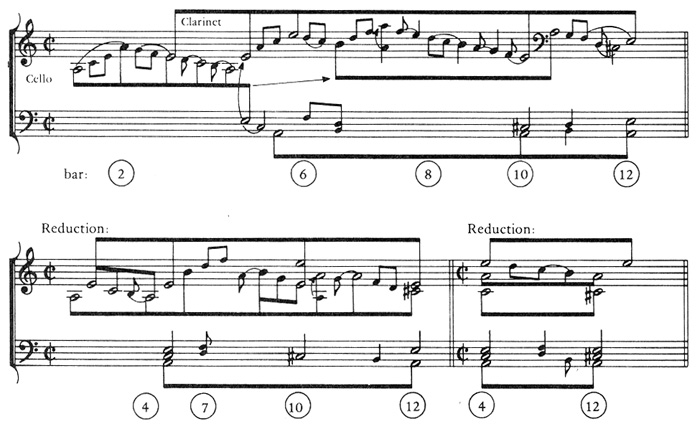
The cello's arpeggio in m. 1 may be played, as one possibility, as part of an entire four-measure phrase, all without nuance. Or the arpeggio may be heard as an upbeat to the downbeat G of m. 2 that is given a "phrase downbeat," following the idea that a stress on the dissonant, active note is stylistically suitable in this style period; then, a second stress could occur on the downbeat A of m. 4. The reading that the G is dissonant is supported when the theme is repeated by the piano starting in m. 22, for in m. 24, the G is a seventh over a I chord, and in m. 25, the clarinet, imitating the piano, plays a G that is again dissonant, now to the IV chord, resolving again to the E that belongs to the I on the third quarter of that measure.
on the third quarter of that measure.
However, this interpretation, accenting m. 2's G and m. 4's A, does little about m. 2's E: its being sustained into the downbeat of m. 3 produces what should be perceived as a syncopation, another common stylistic feature of Brahms' work. Also, this way of playing the opening does not prepare for the clarinet's varied repetition to the theme, beginning with the upbeat to m. 5; nor for the clarinet's expansion of the theme internally, beginning with the B of mm. 6-7, the note that corresponds to the E of mm. 2-3; nor does it indicate any relationship between the first and second themes. The interpretation might be proper, then, but it would lack elegance and would give little indication of later events, perhaps playing its own role adequately but without interaction with the other aspects of the piece.
An analysis, however, yields another possible interpretation. A reduction of the opening cello statement shows that the rest of the theme, mm. 2-4, focuses on the tonic triad that is stated quickly in m. 1:
- the E in mm. 2-3 is approached through the dissonant passing notes G and F;
- the C in m. 3 and the A in m. 4 are similarly approached through passing notes, D and B respectively; and
- the E in the lower octave concludes the statement, with the piano doubling this E and the clarinet picking it up as the first note of its statement.
Mm. 2-4 should be heard, then, as an embellished drawing out of the tonic triad that forms the core of this melodic line; and since the A on the fourth quarter of m. 1 is an octave duplication, the E of mm. 2-3 should be considered the high note of the arpeggio and the first note of the basic layer's upper level:
- the clarinet line's repetition of the theme again plays the arpeggiated tonic triad; but the restatement starts, not on A, as the cello does, but on E; yet
- the clarinet's thematic statement still concludes, as the cello's does, on E (m. 12).
The suggested nuance here is for the cello to play a slight crescendo on its E in mm. 2-3. The effects of this would be:
- to bring out the syncopation resulting from the sustaining of the E into the downbeat of m. 3;
- to establish the stress on the E that is the upper level's basic structural note in this section, as evidenced by the clarinet line that follows, Ex. 6;
- to prepare for the expansion of the inner segment of the theme as played by the clarinet in m. 7, this expansion stemming right from the B, the note that corresponds to the E of mm. 2-3; and
- to indicate the close relationship of this theme to the second theme, Ex. 8.
Then, if the clarinet plays a matching crescendo in m. 6, the ascending thirds figure flows from it, motivated, and the repetition of m. 6's  rhythm in m. 8 begins the compensation for both the crescendo and the ascent in m. 7 with a diminuendo followed by the descent that embellishes the rest of the tonic triad, Ex. 7.
rhythm in m. 8 begins the compensation for both the crescendo and the ascent in m. 7 with a diminuendo followed by the descent that embellishes the rest of the tonic triad, Ex. 7.
Ex. 7.

Note that when the rhythm of m. 2 and m. 6 recurs in m. 8, if a slight tension-crescendo has been played in the two earlier appearances, the syncopation into the next measure need no longer be stressed—it is now expected; and therefore, the diminuendo, by moving into the unattacked downbeat, begins the "tension-releasing" motion toward the closure that will arrive with m. 10's A major triad, to be repeated in m. 12. Note further that throughout the clarinet's extended statement of the theme, the piano maintains an organ point on A, with each attack occurring in the middle of the measure, thereby eliminating all downbeats.
Meanwhile, the piano's right hand and the cello simply continually exchange the F, D and B, inflecting the II chord but omitting any definition of the V that would normally signal a progression to I. The effect of this harmonic stasis is a harmonic analog to the omission of key downbeats: a hovering motion rather than a driving progression.
Now, in order to create that metric analog, the downbeats of mm. 3, 7 and 9 must be felt as omitted. And the clarinet's entry on the upbeat to m. 5 must be felt as also unstressed; and most important, the cello's G in m. 2, like the clarinet's D in m. 6 and m. 8, ought not to be played as a downbeat. If, instead, this G is interpreted as part of a passing motion to the structurally basic E, with the E stressed, some feeling of downbeat would occur with the A of m. 4; but the large feeling of downbeat occurs only with the harmonic arrival in mm. 10 and 12. Such a sustaining of the motion would be much more effective than a fragmentation into measures and phrases. But in order to arrive at such a long line, the lack of a downbeat for m. 2's G and the nuance of a tension-crescendo on the E of mm. 2-3 are necessary.
One further item of interest is that if the first theme is heard as an embellished triad, then the second theme can be heard for what it is, a variant of the first theme. As Ex. 8 shows, the cello's statement (mm. 45-51) first outlines the C major triad, with a vital exchange of roles between the first theme's A and the second theme's G.
Ex. 8.
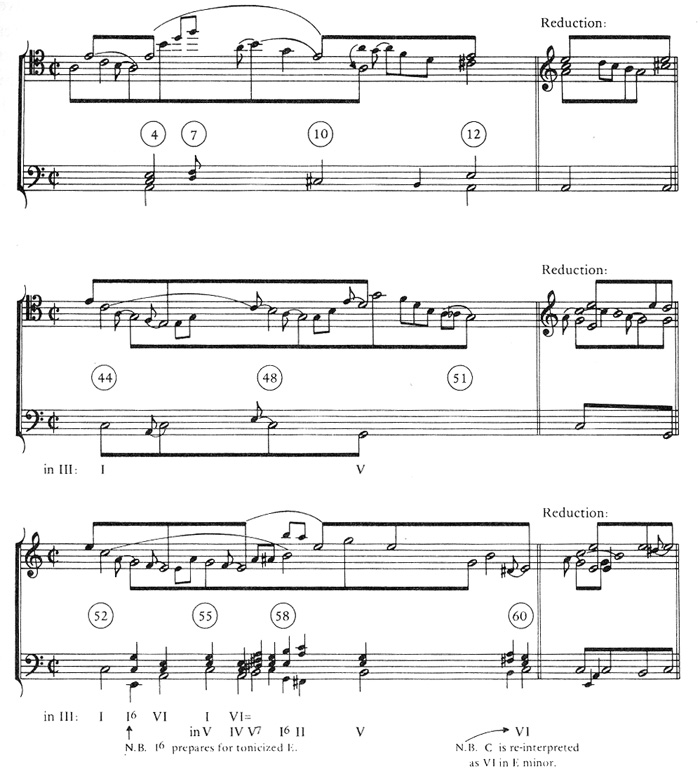
The A that is harmonically stable in the first theme here becomes active, the upper adjacent note to G; and the G that is so noticeable in m. 2, associating there with the C and E, completes that association here, changing from active to stable and, with the C and E, spelling out the C major triad. The tonicization of III, C major, that is prepared and suggested by the first theme is realized by the second.
Then, in m. 47, the C moves to B; in m. 49, the E moves to D; and in mm. 49-51, the descent of an octave from G to G arrives at the cadential G in m. 51, again stressing the G, so that the melody articulates the controlling harmonic motion from a I chord (C-E-G) to a V chord (B-D-G).
Now as it happens with the first theme, the clarinet repeats this second theme, but extends it internally. As Ex. 8 shows, the clarinet also begins with an embellishment of the C major triad; but when this C of m. 52 moves to B in m. 58, the B is harmonically reinforced (by the  in m. 57) and expanded with its octave duplicate. This extra focus on B in this statement replaces the motion to D of the cello's statement; therefore, the notes that remain operative in this statement are B, G and E, so that again the melody's structure expresses its harmonic motion, for these notes spell out the E minor triad that becomes the temporary tonic at the end of the statement, beginning in m. 60 with the deceptive cadence (the V7-VI that re-defines the C major chord as VI in E minor) and arriving clearly at E minor in m. 63. (One may also conjecture that the motion to E minor is prepared not only by the stress on the note discussed above [in regard to mm. 2-3ff.], but by the close association of G as a dependent of E, first in m. 2 and now re-interpreted as the third of the E minor triad.)
in m. 57) and expanded with its octave duplicate. This extra focus on B in this statement replaces the motion to D of the cello's statement; therefore, the notes that remain operative in this statement are B, G and E, so that again the melody's structure expresses its harmonic motion, for these notes spell out the E minor triad that becomes the temporary tonic at the end of the statement, beginning in m. 60 with the deceptive cadence (the V7-VI that re-defines the C major chord as VI in E minor) and arriving clearly at E minor in m. 63. (One may also conjecture that the motion to E minor is prepared not only by the stress on the note discussed above [in regard to mm. 2-3ff.], but by the close association of G as a dependent of E, first in m. 2 and now re-interpreted as the third of the E minor triad.)
Whether or not the derivation of exactly these interpretations from just these particular analyses is convincing, the potential influence of adequate analysis in suggesting and supporting an interpretation should be clear.
1See Jan LaRue, "Style Analysis as an Approach to Courses in Music," SYMPOSIUM 14 (1974), 146-148. Also see p. 150.
2I first became aware of this relationship in about 1959 when Milton Babbitt pointed it out to a class in which I was a student.
3The word "layer" is used here to translate Schenker's term "Schicht"; and the terms "basic layer" or "basic structural layer" are used to translate his term "Hintergrund," since the English word "background" has too many other meanings and connotations. I prefer the term "intermediate layer" as a translation of "Mittelgrund"; and I use the term "surface layer" to translate "Vordergrund." The word "level" is used here to apply to register, as in a "higher" or "lower registral level."
4The "crescendo" referred to here is not only the usual increase in loudness, it is also the "tension-crescendo" described by Hermann Scherchen in Handbook of Conducting, M.D. Calvocoressi, trans. (London: Oxford University Press, 1933) pp. 29-31.
5This "double accent" might be analogous to poetry's "spondee" or to "sprung rhythm," stresses on contiguous syllables, as used by Gerard Manley Hopkins; or it might be that in popular, dance and other kinds of obvious music, meter and rhythm reinforce each other to create a predictable pattern of stress, but in the music of Mozart and other excellent classical composers, rhythm is variable and works with meter's framework to create unpredictable, irregular, asymmetrical stresses. A recognition of this rhythmic inventiveness and subtlety would seem necessary, then, as a means, among others, of identifying the characteristics of Mozart's style.


